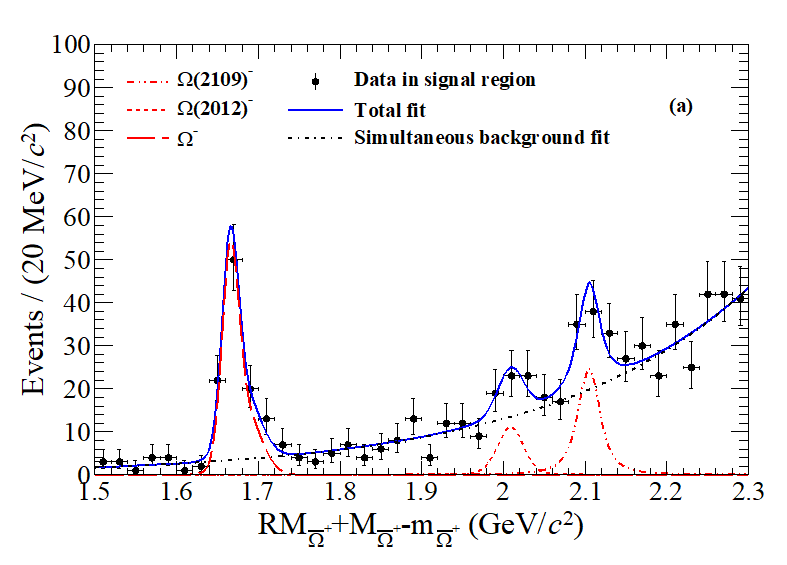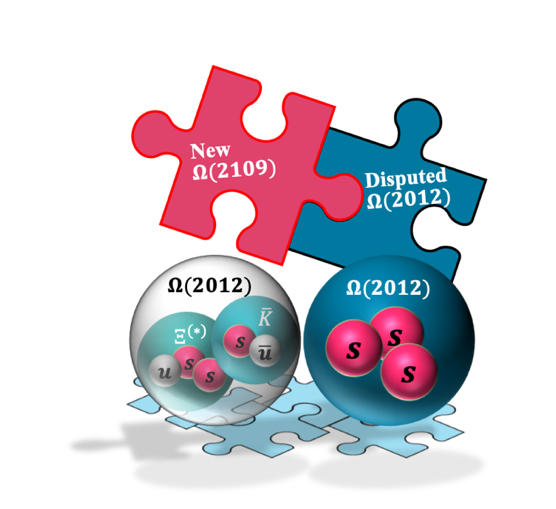

The BESIII collaboration recently reported the evidence for two excited Ω- hyperons. The results have been published in Physics Review Letters on March 4, 2025 [Phys. Rev. Lett. 134, 131903 (2025)].
Baryons are the simplest system in which all three colors of QCD form a colorless object. Understanding their structure and spectroscopy is a necessary component of a real understanding of QCD. However, many fundamental issues in baryon spectroscopy are still not well understood. One of the most important problems among them is the missing excited baryons: the number of observed baryon excited states is significantly smaller than the number predicted in the quark model. Obviously, our present understanding of baryon spectroscopy is clearly incomplete. Thus, searching for the missing baryon resonances and understanding the baryon spectrum are important topics in hadron physics. Compared with other light baryon spectra, our knowledge of the Ω- hyperon spectrum in which three strange quarks are contained, is still very sparse, motivating further searches for Ω- hyperon excited states.
Using data samples with an integrated luminosity of about 19 fb-1 collected by the BESIII detector at center-of-mass energies ranging from 4.13 to 4.70 GeV, BESIII reports the first evidence for a new excited Ω- state, the Ω(2109)-, with a signal significance of 4.1 σ including both the look-elsewhere effect and systematic uncertainties. The mass and width of the Ω(2109)- are measured to be
MΩ(2109)- =[2108.5±5.2(stat.)±0.9(syst.)] MeV/c2
and
ΓΩ(2109)- =[18.3±16.4(stat.)±5.7(syst.)]MeV.
Meanwhile, BESIII also presents evidence for a new production mechanism for the previously identified Ω(2012)- via the process e+ e-→Ω(2012)- Ωbar++c.c. with a significance of 3.5 σ. Figure 1 shows the recoil mass spectrum of Ωbar+/Ω- in the signal region (a) and sideband region (b) in the data, where the red long dashed, red short dashed, and red double-dot-dashed lines are the signal shapes for Ω-, Ω(2012)-, and Ω(2019)-, respectively.


Figure 1: Recoil mass spectrum of Ωbar+/Ω- in the signal region (a) and sideband region (b) in the data.
As illustrated in Fig. 2, the evidence of the Ω(2019)- and particularly its mass, can help clarify the nature of Ω(2012)-, which has sparked a heated discussion among theorists, and also help resolve the puzzle of missing baryon excited states. It is noted that the results are very close to a lattice quantum chromodynamics calculation reported by the Hadron Spectrum Collaboration where the masses of the JP=1/2- and JP=3/2- pair of Ω- excitations are predicted to be around 2.0 GeV/c2 and 2.1 GeV/c2, respectively, implying that Ω(2019)-and Ω(2012)- are probably conventional three-quark baryons, rather than exotic states.

Figure 2: The illustration of the two excited Ω- hyperons.
Reference: Phys. Rev. Lett. 134, 131903 (2025)
Journal publication: https://journals.aps.org/prl/abstract/10.1103/PhysRevLett.134.131903
DOI: 10.1103/PhysRevLett.134.131903